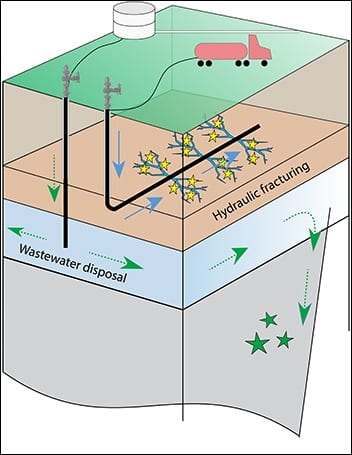An earthquake occurs when there is a release of stress within a layer of rock, usually at a zone of existing weakness within a rock. Earthquakes don’t necessarily happen on existing faults, but once an earthquake takes place a fault will exist in the rock at that location.
However, the above description only caters to tectonic quakes. Earthquakes can also be caused by induced methods or volcanic activity.
Tectonic Earthquakes
The continuous motion of tectonic plates causes a steady build-up of pressure in the rock strata on both sides of a fault until the stress is sufficiently great that it is released in a sudden, jerky movement. The resulting waves of seismic energy propagate through the ground and over its surface, causing the shaking we perceive as earthquakes.
Naturally occurring quakes occur in zones of weakness called faults. These faults are generally broken up into three main groups – normal, strike-slip, and reverse/thrust faults. Further detail on these types of faults and quakes can be found below.
Where the above-mentioned plates meet also creates these zones of weakness, called plate boundaries. They are generally subdivided into divergent, transform, and convergent boundaries. These boundaries are the meeting points for large masses of lithosphere that remain buoyant on the asthenosphere and move at relatively slow rates. An in-depth look at plate boundaries and its types can be found below.
Induced Earthquakes
Induced earthquakes are quakes caused by human activity. These can range from tunnel construction, filling reservoirs, quarry blasts and implementing geothermal or fracking projects.

Fracking or hydraulic fracturing are known to cause earthquakes, even in areas where earthquakes are not historically common. In hydraulic fracturing, a slurry of water, sand, and chemicals is pumped through the ground at high pressures, cracking open rocks to release oil and natural gas. This produces tiny earthquakes that usually can’t be detected without sensitive instrumentation. Disposing of wastewater by injecting it into the crust can also trigger quakes: As the increased fluid pressure migrates away from the well, it can reach a well-oriented fault that is close to breaking and cause it to slip. Since these deeper faults are often larger, they are capable of producing larger earthquakes.
Explosions typically generate earthquake-like seismic waves. These explosions may be set off to break rock while making tunnels for roads, railroads, subways, or mines. Explosions do not cause very strong seismic waves and are generally not felt. Sometimes seismic waves occur when the roof or walls of a mine collapse. These can sometimes be felt by people near the mine. The largest underground explosions, from tests of nuclear warheads (bombs), can create seismic waves very much like large earthquakes. This fact has been exploited as a means to enforce the global nuclear test ban because no nuclear warhead can be detonated on earth without producing such seismic waves. (UPSeis).
Volcanic Earthquakes
Volcanic earthquakes are generally associated with active volcanism. This means that quakes are triggered by pressure changes within the earth, generally associated with the movement of magma or other fluid such as water. These quakes are generally not as powerful as tectonic quakes and occur relatively near the surface. Hence, they are typically only felt in the vicinity of the hypocenter.









